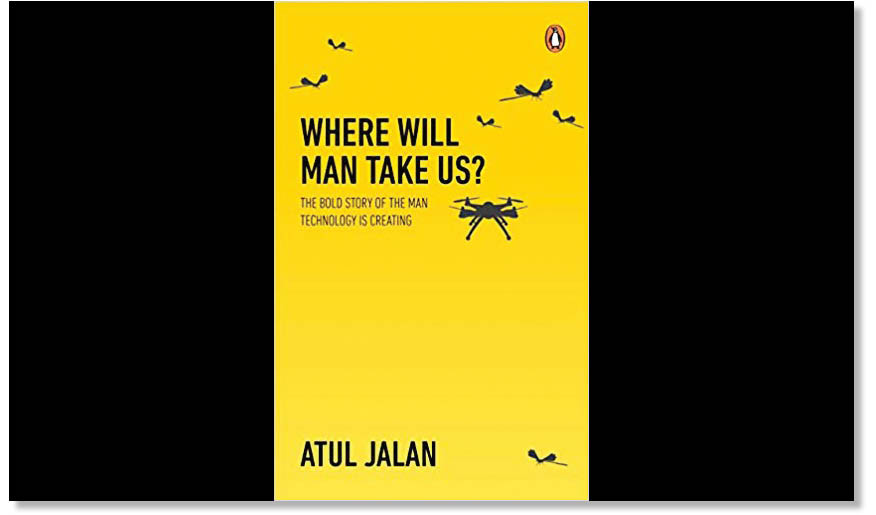The technologies we have invented are merging with our biology, giving us control over pain, disease, ageing and maybe soon, even death, writes Atul Jalan in his new book on our tech-powered future.
One fine day, about 400 million years ago, a fish (let’s call her Wanda) decided to crawl out of the sea. We do not know why her ancestors, happy swimmers all, had over generations developed the four fin-feet that would help her crawl up the beach. Indeed, we do not even know what gave Wanda the gills to believe that she could indeed survive outside water.
We do not know what Wanda was thinking that day or whether fish think at all, but we do know that it was a good day—for that tiny crawl for Wanda was a great leap for mankind.
Fast forward many million years, to say about 3.2 million years ago, and we have Wanda’s descendant, Lucy. Lucy brings us the earliest evidence of a hominid opting to walk rather than swing from the trees.
While Lucy fossilised a few million years ago, debate on what made her descend the tree is yet to die down. And the debate on why she chose to walk. It is possible that our hominid ancestors had to cross large swathes of grasslands between shrinking patches of forests.
What we do know today though is that chimpanzees expend 75% more energy while walking than we do. Which proves that Lucy’s descent was great for our ascent—bipedalism is a distinct advantage.
We do not know why Wanda crawled out of the sea, why Lucy climbed down from the tree or why we stand precisely where we are today, 4.5 billion years after this planet was born. Evolution could have gone a billion different ways. But what it has done is lead us to this stage where we indiscreetly call ourselves Homo sapiens—wise man.
But let’s put the hubris behind us and look at where we stand today.

I consider this day as important and significant for this planet as the day Wanda crawled up and Lucy climbed down. Because while we got here on the back of natural selection, what takes us forward will be, in all probability, artificial selection. Man has neither the time to allow natural selection the few generations it needs for a change in heritable traits nor the patience to accept random mutations. We believe we know what we want to do with ourselves and we are developing the tools to do it. I consider myself very lucky. To have grown up reading Isaac Asimov, Arthur C. Clarke, Philip K. Dick, Robert Heinlein and Douglas Adams and then, as an adult, to see some of those worlds come alive. Maybe it is this childhood love for both technology and sci-fi that has kept me interested in life-technology intersections.
With every passing day, the biology we inherited all the way from Wanda is merging with the technology we have created—changing us as a species. This is a tiger we cannot get off and I wouldn’t recommend that we do.
I like to call ours a Gutenberg moment. As Johannes Gutenberg looked at his first proofs, did he for a moment think that he was flagging off one of the golden ages of mankind? Did his neighbours know that we would be speaking of that day in (almost) the same breath as Wanda and Lucy? I don’t think they did. They would have been more concerned about the price of fish in Strasbourg.
We are witnesses to a similar moment in history, when mankind takes another giant leap. One that will elevate man again—to a species infinitely more sapient. And much like Homo habilis evolved into Homo sapiens (via many other Homos), we might evolve into a new species. A new man altogether.
The technologies we have invented are merging with our biology—giving us control over pain, disease, ageing and maybe soon, even death. This, makes us our own gods. From here on, we can no longer be content with being mere humans.
This realisation and this unbelievably exciting time is what Where Will Man Take Us? is all about. We should not make the same mistake Gutenberg’s neighbours did. Where Will Man Take Us? looks at how all of this is coming about. It looks at the drivers of change—artificial intelligence (AI), nanotechnology and genetics. At how this is impacting us as a society. At how the new-found powers of science and math might help us solve some of man’s greatest mysteries. And, of course, at this new species that we might evolve into.
If we look at our history as humans, we see two distinct abilities and their consequences running together—our ability to invent stories and our ability to turn these stories into technology. Both, in turn, reinvent us.
Wheel to steam engine to electricity to telephone to Google—all are our inventions that have reinvented us. Each of them changed our life so much that those of us who have lived through any of these epochal changes cannot remember how life was before this. I struggle to wonder how I managed before mobile telephony and Google arrived at the scene.
This time around, the technologies reinventing us are AI, genetic engineering, nanotechnology and quantum computing.
Everything around us, I contend, can only get better with cognification. And that makes AI the next electricity, the next driver of human reinvention. But what I find even more exciting is that in our quest to bring humanlike cognition to AI, we are forced to examine ourselves and our brains a little more closely—what is it to be human? What is self-awareness? What is consciousness?
While these questions are man-old and have been pertinent since the time we started gossiping around a fire, it is only now that science has acquired the ability to bring us some pertinent answers. What could only be answered by philosophy and religion in the past can now be viewed and analysed through quantitative, algorithmic and scientific lenses.
AI’s ability to crunch infinite amounts of data and math’s ability to find patterns could also help us unravel some of our greatest mysteries: astrology, alien life and the secret to eternal happiness.
Where Will Man Take Us? also looks at advancements in genetics. With the ability to edit the genome, we really are heralding an end to natural selection. The end of randomness in human evolution truly marks the beginning of man’s next avatar.
Excerpted with permission from ‘Where Will Man Take Us: The bold story of the man technology is creating’, by Atul Jalan, published by Penguin Portfolio

